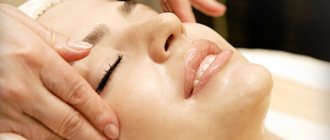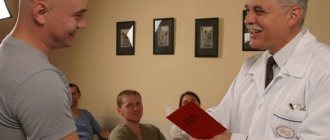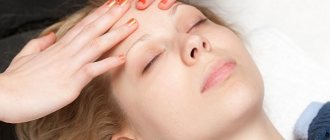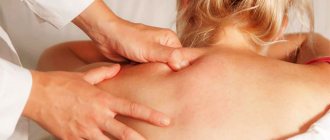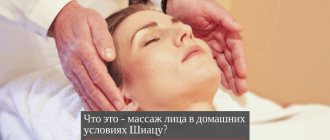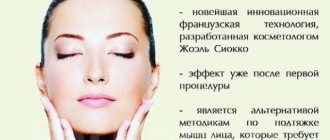The skin of the face is much more exposed to negative effects than other tissues. The skin of a young body is able, with the help of a huge amount of its own quickly restored resources, to resist the destructive influence of various external factors, but with age, this ability becomes a luxury, and the body is no longer able to fight on its own.
So, after 35 years, most women begin to notice how their skin loses elasticity, their face changes color and acquires treacherous wrinkles. Such symptoms only indicate that age cannot be hidden, and it will still take its toll. Or will you hide it?
What is myofascial facial massage?
Any woman wants to look younger, and to achieve this goal, the fair half of our society turns to the help of the modern beauty industry, which offers a rich assortment of the most diverse and, most importantly, effective techniques for prolonging youth. Most of them are very harmful and leave their mark on health. However, there is another method, which, due to its effectiveness, has become quite widespread - and this is massage.
Important: Massage procedures, contrary to popular belief, are a strong restorative agent with a healing effect. The main thing is to choose the right type of massage and entrust it to a professional.
Of course, not just any massage will do. We are talking about a unique procedure that can get rid of signs of aging skin, namely myofascial facial massage. Its peculiarity is that during the procedure, the massage therapist applies pressure not on the skin, but on the connective tissue between the muscles, called fascia (it’s not hard to guess where the name of the massage came from).
A little more about the name: in order to fully understand the principle by which massage techniques affect the skin, you need to understand what myofascial groups are - a collection of muscles and fascia that form myofascial meridians. It is with their help that you can improve the functional activity of the dermis.
In terms of technique, this procedure cannot be called easy - it requires certain knowledge in the field of anatomy, skills in acupressure, etc. If you perform actions carelessly and without due care and attention, such a procedure, unfortunately, will not bring you the expected result. Considering that we are not talking about some part of the body that can be hidden under clothing, but about the face, the risk is not at all justified, and therefore it is better to entrust the performance of myofascial massage to an experienced specialist who can guarantee high-quality, safe and effective manipulation.
Important: An experienced massage therapist can, by influencing the fascia, improve their flexibility and restore their tone. As soon as the tension is removed, the muscle fibers will be able to work in the desired mode.
According to statistics, the myofascial technique has, in principle, gained particular popularity among athletes. With its help, they manage to reduce the risk of injury even under extreme loads. For others, this technique is an excellent tool in the fight against equally important problems, such as tension, muscle pain, fatigue, etc.
Despite the fact that this type of massage involves the use of classical techniques (pinching, rubbing, smoothing, etc.), the technique is still unique:
- The massage therapist does not use moisturizers to ensure gliding on the skin;
- The procedure can be adapted for each individual case for a particular person.
Useful video
For a detailed study of the myofascial technique for influencing the dermis of the face, do not neglect the opportunity to familiarize yourself with the complete list of information that can easily be found on the vastness of the global network.
At the same time, we have prepared for you thematic video materials in which experienced cosmetologists and massage therapists describe the essence and purpose of the procedure, not forgetting to give useful recommendations regarding its implementation. In fact, you will discover a lot of new and useful data that will allow you to get maximum efficiency from manipulation.
Surround your dermis with quality care, based on modern methods of mechanical action. Myofascial massage is an effective technique for combating age-related changes and toning the skin at the cellular level .
Every year there are more and more fans of this method of skin care. And this is not surprising, because its efficiency and practicality provide the best conditions for achieving the task. Find a suitable salon for yourself in your city, make an appointment with a responsible specialist and start today towards rejuvenating your appearance.
The benefits of myofascial massage
On the head and neck, fascia forms sheaths for muscles, is part of the structure of ligaments and tendons, and houses blood vessels and nerves. By influencing them correctly, you can significantly rejuvenate the appearance of your face. And this is not all that myofascial massage can do - its benefits lie in the following changes:
- muscle pain disappears;
- deformed muscles restore their correct shape;
- muscle mobility returns;
- muscle tension is relieved;
- the oval of the face is corrected;
- asymmetry is eliminated;
- wrinkles disappear;
- metabolic processes are normalized;
- tissues are saturated with oxygen;
- blood circulation improves;
- lymph flow accelerates;
- toxins and harmful substances are removed;
- swelling is eliminated;
- cell regeneration is activated;
- collagen production is stimulated.
The effect of this procedure is often compared with the result of a circular lift - this is an ideal oval face, elastic skin with a healthy color, and the absence of wrinkles. At the same time, having rejuvenated, the patient also receives good health, absence of migraines and normalization of heart rate.
Important: To achieve amazing results, you should undergo a full course of procedures - as a rule, these are 10-15 sessions, after which you will be able to lose 5-7 years in appearance.
Consequences of dysfunction
For various reasons, the structure and functions of the fascia can be disrupted, causing a lot of problems for a person.
- Excessive physical activity often causes muscle spasms, causing the fascia to become damaged or hardened, creating tense, painful areas.
Relieving pain in the legs: calf massage - Active muscle contraction increases the load on the connective tissue structure: the fibers are deformed (shortened or stretched), changing the position of the internal organs, disrupting their normal functioning, limiting mobility.
- Prolonged muscle spasms often cause the development of inflammation and degenerative changes in the structure of fascial fibers. And these processes are almost always accompanied by increasing pain.
- Dehydration or damage to tissue cells often causes changes in the shape and internal structure of the fascia, disrupting their conductivity. As a result, metabolic processes are inhibited: tissues do not receive enough oxygen and nutrients, which leads to rapid aging of the body.
Fascial tissue is often called the “sixth sense organ.” After all, free nerve endings, receptors responsible for pain and movement “sensors” are located here. Any disruption of the functioning of the “peripheral brain” can lead to sad results: we will stop coordinating any movement of the body in space and feel pain, which, as is known, is a signal warning of problems with the body.
One way to relieve back pain is to massage your lower back.
Indications and contraindications
Experts note that the solution to most problems with the help of this massage is a reaction to the launch of self-healing physiological processes that the procedure provokes. This allows us to recommend myofascial facial massage for the following symptoms:
- Loss of facial skin elasticity;
- Poor muscle tone;
- Excessive fat content;
- Acne, sebaceous plugs, pimples;
- Having a double chin;
- Swelling;
- Postoperative period;
- Head moth;
- Hearing loss and other ear diseases;
- Eye diseases;
- Drooping corners of lips;
- Bruises under the eyes;
- Recovery after a stroke.
The massage can be performed even on children, which once again confirms its uniqueness.
However, despite such an impressive list of indications and beneficial qualities of this procedure, it, like any other massage, has its contraindications:
- Oncological diseases;
- Open tuberculosis;
- Presence of open wounds and bites;
- Herpes;
- Mentally unstable condition;
- Atherosclerosis;
- Allergy;
- Head injuries;
- Brain bleeding;
- Osteoporosis;
- Blood diseases;
- Heat;
- Hypertensive crisis.
Important: Before deciding to undergo this procedure, it is advisable to consult with a specialist - otherwise you can harm your health and get the opposite effect from the procedure.
Cost of the procedure
In Moscow and St. Petersburg, the price per session ranges from 1,500 to 3,000 rubles - this is a lot, considering that the course consists of at least 6 procedures.
When choosing a salon, focus primarily not on the cost of the services offered, but on the qualifications of the massage therapist, which must be confirmed by a Diploma of Higher Medical Education and a Specialist Certificate certifying his right to use myofascial techniques in practice.
People have always dreamed of a product that provides eternal youth. It seems that now it has been found: in just 30 minutes, the skillful hands of a master will relieve fatigue and erase the years from your face, making you healthier, more beautiful and happier.
The nuances of performing myofascial massage
To improve the functioning of muscle and fascial tissues, myofascial massage uses several techniques and even elements of manual treatment. To achieve the greatest effect, the procedure should be carried out in a comfortable environment - this will ensure relaxation of the patient.
Before the procedure, it is advisable to cleanse the skin of cosmetics and other contaminants, otherwise oxygen will not be able to reach the site and have the desired effect. Only after following these rules can you begin the procedure and work on the head, neck and face.
The session will look like this and you should be prepared for this in order to feel confident:
- A professional massage therapist will begin the procedure with a casual conversation - this will allow him to establish contact and create a relaxing atmosphere.
- Without fail, the specialist must ask about your well-being and find out if there are contraindications or any other problems that are worth paying attention to.
- Then a diagnosis is carried out - the patient is placed on his back and by examining special points on the face and applying pressure to the skin, the massage therapist determines problem areas.
- The massage plan is created individually for each patient, and therefore, based on the diagnosis, the doctor must determine which techniques and techniques he will use.
- All movements are performed following the breathing rhythm.
Usually the first session does not exceed 30 minutes in duration. Then the session time increases.
Important: If during a massage the patient experiences discomfort, acute pain or malaise, the procedure should be stopped immediately.
Performing self-massage at home
When conducting a session at home, you must first clean and degrease the skin. Then you should steam your skin by holding your face over a pan of hot water. If desired, you can add a few drops of any essential oil to the water. After steaming, you need to treat your hands with disinfectant. Massage actions are performed according to a similar (as for a salon) scheme. In this case, all movements should be smooth and easy. It is not recommended to violate the order of actions and introduce your own techniques.
Before the session, you should determine the so-called trigger points. These zones can be recognized by pain sensations that spread beyond the trigger nodes. At the initial stage, you can simply massage these areas without pressure or strong pressure. Full massage actions are recommended to be performed only by those who are familiar with the impact techniques.
Technique
To carry out myofascial facial massage, three basic principles are taken as a basis, which, regardless of the problem and purpose, will be used without fail. So, during the procedure the specialist will definitely use:
- Stretching and relaxation. Using this technique, the specialist acts on the deep fascial layers - the movement allows you to work out the muscle fibers and stimulate cell restoration. At the same time, the application is carried out extremely slowly in order to determine the proper resistance of the fibers and not damage the skin. An important nuance is the fact that the master’s hands should under no circumstances rub the skin. The result of the technique should be the release of the client’s facial tissues from stagnation.
- Skin hanging. A stage that creates a lifting effect and involves working with the subcutaneous layers. Using this technique, you can form a tight connection of tissues, tightening the skin that has lost its elasticity. It looks like this: the massage therapist temporarily suspends the problem area for just a couple of seconds and relaxes it. No pinching movements - just tension, from which the dermis should not break.
- Massaging muscle mass. As soon as the facial muscles are relaxed, the master should work on problem areas by moving them to the side and back. This technique triggers the work of the fascia and stimulates the rejuvenating effect.
Helpful advice: The main thing is to always (no matter what kind of massage you have) follow certain rules and each patient should familiarize themselves with them immediately before going to a specialist.
This knowledge will allow you to determine whether you really entrusted your skin and face to a professional, and not to an amateur who has no experience behind him and only has a diploma of completing a 2-week massage course.
Here are just a few aspects that should not be overlooked, otherwise there is a chance of ending up with an irresponsible massage therapist and getting exactly the opposite of the expected effect.
- Responsibility. As soon as you decide to have a massage and inform the specialist about it, he should inquire about your state of health. Not a single self-respecting specialist, much less a professional in his field, will undertake the procedure until he finds out all the features of your body and learns about the presence of certain contraindications.
- Attentiveness. The massage therapist must monitor the patient’s condition, indicate a more correct posture, achieve relaxation of the muscles and the whole body, recommend proper breathing techniques, etc.
- Order of stages. Myofascial massage should begin in a lying position, the specialist identifies problem areas and works on areas of the skin that need treatment. You can even complete the procedure on your side.
- Gradual increase in pressure. Each session involves increasing pressure on the skin and increasing the time of the entire session. By the end of the course, one session can last about an hour and a half.
There are only four main stages of massage:
- Cleansing the skin of cosmetics and pollution;
- Softening the skin by gently affecting it;
- Movement from the chin to the ears.
- Carrying out a deep massage in the forehead area.
In this case, no softening creams should be used - all movements are performed dry. The specialist must move strictly along the muscle fibers in order to achieve greater effect without harming the skin.
How does the session work?
To feel calm and confident, the patient must understand what awaits him during the procedure:
- A myofascial massage session always begins with a conversation. An experienced massage therapist will try to establish contact with the patient from the first minutes and create a warm atmosphere - because this is the only way you can get distracted and relax as much as possible.
- The master will definitely ask about your well-being, existing problems, diseases and characteristics of the body.
- The next stage is diagnostic. You will be asked to lie on your back, and the massage therapist will “examine” every centimeter of your face, scalp and neck with his hands, and determine the presence of muscle spasms and points of particular tension.
- Treatment methods are selected for each patient. The most common techniques used are pressure, twisting or stretching.
- Any manipulation is adjusted to the breathing rhythm: slow and calm inhalation and exhalation is carried out in five beats.
The first session lasts no more than 30 minutes. Each subsequent one becomes more intense and longer lasting. During the procedure, the master constantly monitors the patient’s condition and at the first symptoms of malaise or discomfort immediately stops working.
Areas of influence
So, you have cleaned your face of makeup, relaxed and are ready to begin the procedure. Now you can gradually work on the main areas of influence: head, neck and face.
- Head.
This category includes the tendon helmet, temporal fascia and auricles. The technique looks like this:
- Massage the scalp with both hands clockwise;
- Kneading the skin, first laying the patient on his side and placing his thumb in front of the auricle, and the rest in the scalp;
- Working on the forehead by moving the index finger and thumb towards each other and to the sides.
Relaxation of the muscles of the forehead area plays a huge role in myofascial facial massage, as it ensures smoothing of transverse and longitudinal wrinkles. As a result, age-related changes in tissue are achieved.
- Neck.
This area contains a huge amount of fascia: they play the role of sheaths for muscles, act as fasteners, connect muscles to the vertebrae and form the neck itself.
All these structures can be affected by circular movements, rubbing, rolling, kneading. You should move to the chin only after relaxing the frontotemporal area.
Important: Remember that neck massage must be carried out carefully - do not damage the main arteries, nerve bundles and other important organs, otherwise it can be life-threatening.
- Face.
Finally, the face itself. After cleaning from contaminants, the master must conduct diagnostics and assess the condition of the muscles and tissues. The skin should not stretch during the procedure, otherwise you can get the opposite effect. Clockwise, important points under the corners of the lips are worked out, from them the impact is on the cheekbones and attention is paid to facial wrinkles. The massage ends with the bridge of the nose and temples.
In this case, the techniques should replace each other gradually, not abruptly.
Shubina's technique
Tatyana Shubina, a physiotherapist and teacher at the school of exclusive massage techniques, claims that changes in the functions of muscle tissue become the mechanism that triggers the aging process of the body.
Inspired by oriental manual practices, Shubina created a myoplasty technique that allows one to effectively work on the deep tissues of the head and face without unnecessary energy expenditure. The technique involves influencing the fascia, which eliminates muscle deformations, shortening of fibers, blocks, spasms, and thereby helps slow down age-related changes in the face. The author pays great attention to:
- palpation diagnostic techniques that allow you to “listen” to the deep structures of the body;
- relaxation of the fascia of the skull, temporal and parotid zones, considering that the condition of the facial muscles depends on them;
- activating the lymphatic drainage system and combating swelling by removing excess fluid;
- methods for eliminating a double chin;
- oval correction, facial modeling.
You can get acquainted with the author's techniques and techniques by watching a training video.
